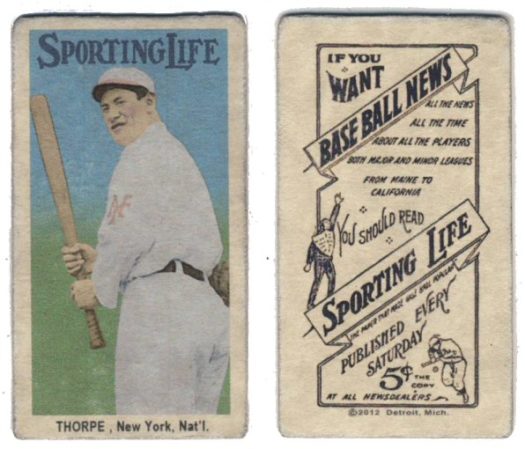Collector score: *** (2 Stars)
Sporting Life cards should not be confused with the original Sporting Life baseball cards, issued over 100 years ago. The original Sporting Life cards are very rare, beautifully made litho printed cards. This may be confusing to novice collectors.
The new Sporting Life cards are created by Jerrold Andrews III of Detroit, Michigan. Like Helmar Brewing (which is also a Detroit maker of inkjet-printed cards) this company is using an old and venerable name to market their products, which are sold on eBay. The inkjet-created Sporting Life cards are in no way connected with the original sports magazine or cards, a company which has been out of business for over 80 years.
The company claims that less than two dozen of each card is made. Recent selling prices range from $5 to over $200 for a single card. Like all cards created on an inkjet printer, these cards have no value as collectibles. This is because the inks used to produce them will last only a few years under the best of conditions. They will not survive long enough to acquire any age-related value.
In fact, as they get older they will begin to fade. As this becomes more and more noticeable, they will be worth less and less. This is the exact opposite of a collectible card, which becomes increasingly valuable with age. These cards are “worth” the most when they are brand new, and the older they become, the less value they will possess, as their condition deteriorates.
It does not matter if pigment inks are used, or archival acid-free stock, or art sprays. There is no current technology that will enable anything printed on an inkjet printer to survive long enough to become a treasured antique. Cards printed on a press, using traditional inks (offset-litho) can last essentially forever. Ink jet creations use water-based inks which are broken down by tiny molecules of moisture in the air, by light, and by ozone. Even if kept in museum conditions, they will not survive more than a few years.
The cards made by Sporting Life are attractive, and look like a vintage card ought to. They come in a variety of shapes and sizes. Like Helmar, they are intentionally damaged to make them look old. It’s a damn shame they won’t ever be as old as they look!
These cards may have some value as folk art or as a conversation piece, but they can not have any value as collectible cards, because they are only temporary.
PRICING: If you own one or more of these cards, and wish to sell it, how much should it go for? Assuming you’re going to be honest about it, you can’t really sell it as a collectible, because it is new, and because it is only temporary. So it becomes a modern reproduction, an “objet d’art” if you will. As with all art, it should be priced based on aesthetics and whatever similar items are selling for. There are people who buy these cards all the time, apparently knowing exactly what they are getting. In describing the item, I would advise that you avoid two terms: “rare” and “collectible” because inkjet-created cards are not rare, since they have a print run which is open-ended and can be easily reproduced by anyone. And, as mentioned above, they will not last long enough to be collectible.

